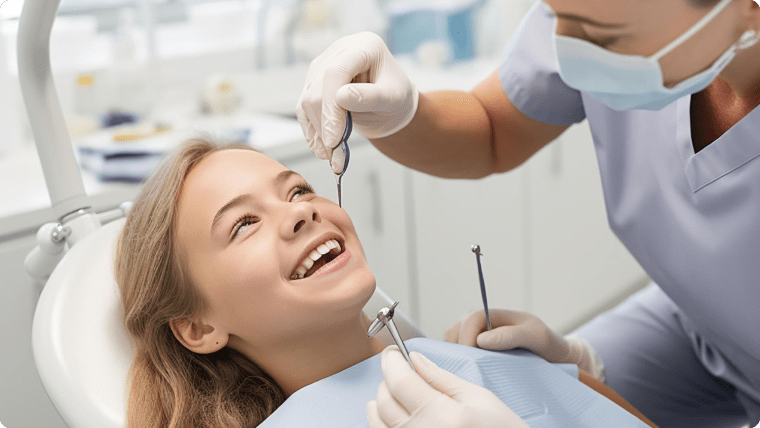
What is the Oral and Dental Health Department and Which Diseases Does It Cover?
The Oral and Dental Health department is a branch of medicine that provides health and care for structures around the mouth such as the mouth, teeth, gums and jaw. This department covers a wide range of diseases from tooth decay to gum disease, from jaw disorders to aesthetic dental treatments. Oral and dental health is an important part of general health, and the treatments performed in this department aim to increase the quality of life of patients.
About the Department of Oral and Dental Health
The Oral and Dental Health department is a health unit that provides both preventive and therapeutic services, managed by a team of dentists and specialists. In this department, regular check-ups, dental cleaning, fillings, root canal treatment, treatment of gum diseases and aesthetic dentistry are performed. In addition, treatment services are provided in special areas such as jaw surgery and orthodontics.
Who is an Oral and Dental Health Specialist and What Are Their Duties?
An Oral and Dental Health specialist is a doctor who has received training in oral and dental health and specializes in dentistry. Their duties include diagnosing and treating dental and gum diseases, correcting disorders in the jaw and teeth structure, preparing and applying dental prostheses, and performing aesthetic dentistry procedures. They also provide training on oral and dental health protection and raise awareness among patients on this issue.
What are the diseases treated in the Oral and Dental Health Department?
The Oral and Dental Health department diagnoses and treats many diseases related to the mouth, teeth and surrounding tissues. Here are the main diseases treated in this department:
Tooth Decay:
Tooth decay occurs as a result of the destruction of tooth enamel by bacteria. If left untreated, it can lead to pain, infection and tooth loss. In this section, decay is treated with methods such as filling, root canal treatment or tooth extraction.
Gum Diseases (Periodontal Diseases):
Gingivitis: Characterized by inflammation of the gums. In the early stages, bleeding and swelling of the gums may occur. If left untreated, it can turn into periodontitis.
Periodontitis: It is an advanced inflammation of the gums and can cause damage to the bone structure that supports the teeth. It is treated with gum cleaning and surgical interventions.
Tooth Sensitivity:
It manifests itself with sudden and sharp pain in the teeth in response to hot, cold, sweet or acidic foods and drinks. In the treatment of tooth sensitivity, fluoride applications, desensitizing toothpastes and filling procedures are applied.
Temporomandibular Joint Disorders (TMJ Disorders):
These disorders, which manifest with symptoms such as pain in the jaw joint, difficulty chewing, and limited jaw movement, are evaluated in the oral and dental health department. Treatment options include the use of bite plates, physical therapy, and surgical interventions.
Clenching and Grinding Teeth (Bruxism):
It occurs when teeth are unconsciously clenched or grinded during sleep or in stressful situations. This can lead to tooth wear, jaw pain and headaches. The use of a night plate is common in treatment.
Receding gums:
The receding gum line can expose the roots of the teeth and cause sensitivity in the teeth. Gum treatment is used to stop the progression of this problem and provide aesthetic improvement.
Dental Calculus Formation:
It occurs when plaque hardens over time and turns into tartar. Tartar can cause inflammation in the gums and increase the risk of decay. Tartar is removed with the tartar cleaning (scaling) process.
Mouth Sores and Canker Sores:
They appear as painful, white or yellow sores inside the mouth. They usually heal on their own, but medications and mouthwashes can be used to relieve pain and speed up the healing process.
Bad Breath (Halitosis):
It is usually caused by oral bacteria, gum disease or tooth decay. Determining and treating the root cause is important in eliminating this problem.
Orthodontic Disorders:
Situations where the teeth are not properly aligned require orthodontic treatment. In this section, irregularities in the jaw and teeth structure are corrected with braces (brackets) applications.
What are Oral and Dental Health Examinations?
Oral and Dental Health examinations include a detailed examination of the teeth, gums and structures around the mouth. During these examinations, problems such as tooth decay, gum disease, jaw structure disorders, and tartar are detected. Routine dental check-ups are very important for maintaining dental health and detecting potential problems at an early stage.
What are the treatment methods applied in the Oral and Dental Health Department?
In the Oral and Dental Health department, various treatment methods are applied according to the needs of the patients. These methods include filling, root canal treatment, tooth extraction, prosthetic applications, gum treatments, jaw surgery, orthodontics (braces treatment), implant applications and aesthetic dental treatments. Treatment methods are determined according to the type of disease and the general health status of the patient.
What is done during an oral and dental health examination?
During the Oral and Dental Health examination, the dentist first evaluates the patient's general oral and dental health. During this examination, the teeth, gums, tongue, palate and jaw structure are carefully examined. If necessary, dental X-rays are taken and the tooth roots and jaw bones are also evaluated. As a result of the examination, the dentist recommends the appropriate treatment plan for the patient and initiates the necessary treatments.
When Should You Go to the Oral and Dental Health Unit?
There is no need to have a specific complaint to go to the Oral and Dental Health unit. Regular dental check-ups every 6 months are important for early diagnosis and treatment of possible dental and gum diseases. In case of complaints such as toothache, bleeding gums, mouth sores, tooth sensitivity, a dentist should be consulted as soon as possible. In addition, the Oral and Dental Health unit can be consulted for aesthetic treatments.



